U |
nderstanding how cities view and evaluate projects is critical to developing more cooperative and insightful relationships between your company and the communities in which you do — and would like to do — business. This article presents an overview of how public officials view and evaluate the community impacts associated with economic development projects. Data presented in this article is based on a national survey of municipal economic development officials working in U.S. cities with populations between 10,000 and 300,000. Research involved investigating the structure, subsidy determination, involvement of public and elected officials, the decision-making processes and the analytical methods used by the public sector to evaluate municipal-level development projects.
Corporate site selection is a complex art and science. The skills required of corporate real estate executives and site selection specialists rival the skill level of almost any professional in the business world. The ability to weight correctly the complex interrelationships of location trade-offs, development incentives, community advantages, market limitations and municipal politics is no simple task. The site selection decision-making process is further complicated by the demanding requirements imposed by corporate management’s goals and company strategic planning objectives.
Perhaps the most challenging part of corporate real estate is negotiating with potential communities. Each location has a different array of benefits, incentives and amenities to offer the corporate citizen. Skills in limiting municipal exactions in project development or maintaining damage control in communities where your firm closes a plant or operation must be in place. As corporate real estate practitioners, we use a variety of impact-analysis tools to prove to communities what good citizens we are and what benefits our firm has for the community. These analytical tools include objective economic, fiscal, market value, infrastructure and environmental impact studies. But how does our public sector counterpart, the municipality, evaluate the benefits of your firm as a member of their community?
Survey Respondents
The research in this article is based on a national survey of municipal economic development officials regarding their views on and practices in municipal economic development. Surveys were sent to a random sampling of economic development administrators in 1,500 of the 2,600 U.S. cities with populations between 10,000 and 300,000. Slightly over 27 percent of the cities responded to the survey. The economic development administrators completing the survey were identified through the National League of Cities as having management responsibility for the economic development activities in their respective communities. The respondents to the survey fell into the following professional categories: economic and community development managers, elected officials and planning and zoning officials and individuals managing public development corporations.
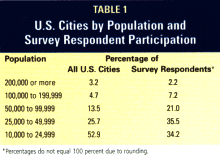 Based on population, the distribution of cities responding to the survey differed in composition from the actual distribution of U.S. cities. Fewer officials responded to the survey from cities with populations over 200,000 and from cities with populations between 10,000 and 24,999. Table 1 shows city population ranges in relation to the actual composition of U.S. cities and that of the survey respondents.
Based on population, the distribution of cities responding to the survey differed in composition from the actual distribution of U.S. cities. Fewer officials responded to the survey from cities with populations over 200,000 and from cities with populations between 10,000 and 24,999. Table 1 shows city population ranges in relation to the actual composition of U.S. cities and that of the survey respondents.
From the perspective of a corporate real estate executive or site selection specialist, the value of developing better relationships with and knowledge of public-sector economic development practices is critical. More and more, municipal economic development activities are being reviewed (and criticized) by elected officials and citizens. From a corporate perspective, this results in site selection and expansion options becoming more constrained. For many projects, this public criticism will ultimately mean higher site costs and concessions on the part of the corporation seeking to locate or expand in a certain community.
For some projects it will mean that the second or third most desirable location will have to be accepted. By developing a better understanding of public-sector economic development analysis and decision making, corporate real estate executives can identify and successfully address the most critical community and project variables surrounding corporate real estate projects.
Municipal Economic Development Practices
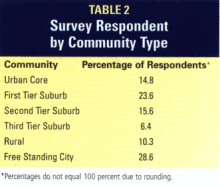 It is important to point out the type of community in which the survey respondents worked. Table 2 identifies the respondents’ community type.
It is important to point out the type of community in which the survey respondents worked. Table 2 identifies the respondents’ community type.
The survey also considers the administrative setting where municipal economic development activities are based. The value of this information is that an economic development agency’s organizational setting can provide insight as to the public sector’s views towards projects. Generally, we could assume that planning and zoning officials are highly structured and quantitative in their approach to projects and that economic development projects under their consideration should be highly consistent with comprehensive land use plans. The approach to economic development by planners can be described as the “rational model.” Public officials working under the rational model can be obsessed with data collection and process related issues that could seriously delay a project.
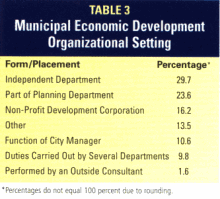 If an economic development department is independent of other municipal departments, then the underlying motivation toward projects and the reward structure would be based less on the defined rational goals of a planning model and more on a definition of success determined by the number of sites marketed and employers retained in the community. Accordingly, independent economic development departments can be perceived as more sales oriented in nature.
If an economic development department is independent of other municipal departments, then the underlying motivation toward projects and the reward structure would be based less on the defined rational goals of a planning model and more on a definition of success determined by the number of sites marketed and employers retained in the community. Accordingly, independent economic development departments can be perceived as more sales oriented in nature.
Table 3 shows the composition of organizational settings for economic development departments surveyed.
Over 73 percent of the economic development officials responding to the survey described their community as having proactive economic development policies; only 26.5 percent of the respondents felt that their community’s economic development policies were reactive in nature.
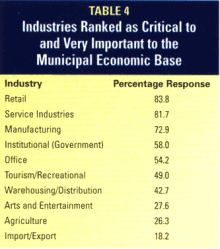 Survey respondents were asked to rank general industry groups by the degree of importance to their respective community’s economic base. Retail was the leading industry group with almost 84 percent of economic development calling it critically important or very important to their economic base. Surprisingly, manufacturing (the industry group with the highest income multipliers for a community) was ranked third with only 73 percent referring to it as critical to or very important to their community’s economic base. Table 4 shows how other industries’ fared in this area.
Survey respondents were asked to rank general industry groups by the degree of importance to their respective community’s economic base. Retail was the leading industry group with almost 84 percent of economic development calling it critically important or very important to their economic base. Surprisingly, manufacturing (the industry group with the highest income multipliers for a community) was ranked third with only 73 percent referring to it as critical to or very important to their community’s economic base. Table 4 shows how other industries’ fared in this area.
It is helpful to see how economic development officials rate the advantages of their communities in attracting new businesses. As a point of reference on key location factors for corporate real estate executives, Table 5 shows the results of a 1993 survey by Conway Data (Site Selection, 1994) that ranked overall key location factors.
 Table 6 shows how municipal economic development officials rated community advantages in terms of being very important in attracting new businesses and retaining existing businesses.
Table 6 shows how municipal economic development officials rated community advantages in terms of being very important in attracting new businesses and retaining existing businesses.
These surveys of corporate real estate executives and economic development administrators are not intended to be comparable. They were conducted at different times, on different groups and with entirely different objectives in mind. However, some general statements can be made about the ratings of the two groups regarding location advantages. Public-sector economic development officials tended to value the community advantages that are more illusive to define and abstract in nature. Such highly rated community advantages as quality of life, quality workforce, work ethic and good schools are hard quantify. On the other hand, corporate real estate executives were more concrete in defining community characteristics and corporate cost factors deemed “reasonable” that could be objectively compared between communities.
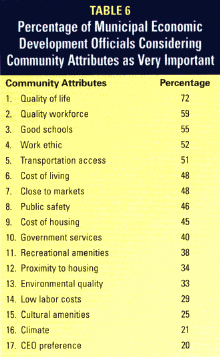 What do the differences in the two location advantages list mean? Municipal economic development program administrators value and market what they have within their respective communities. They will of course respond to corporate requests for information on the physical characteristics of sites, site ownership, site costs and preparation requirements as well as local community, utility and transportation matters. However, economic development practitioners lack the ability to control their community’s fundamental economic factors, yet they were expected by their superiors and citizens to produce development results. Accordingly, economic development officials value and market their community’s benefits. The economic development administrator cannot make up for their community’s shortcomings but they can improve their community’s image by marketing their community advantages and target marketing to corporations.
What do the differences in the two location advantages list mean? Municipal economic development program administrators value and market what they have within their respective communities. They will of course respond to corporate requests for information on the physical characteristics of sites, site ownership, site costs and preparation requirements as well as local community, utility and transportation matters. However, economic development practitioners lack the ability to control their community’s fundamental economic factors, yet they were expected by their superiors and citizens to produce development results. Accordingly, economic development officials value and market their community’s benefits. The economic development administrator cannot make up for their community’s shortcomings but they can improve their community’s image by marketing their community advantages and target marketing to corporations.
Measures of Development Costs and Benefits
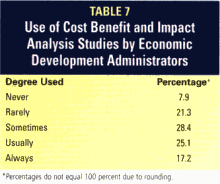 Economic development administrators were asked how frequently they used cost benefit and impact analysis techniques to evaluate projects. Table 7 shows the degree to which their respective agency or department performed a cost benefit or impact analysis study on projects,
Economic development administrators were asked how frequently they used cost benefit and impact analysis techniques to evaluate projects. Table 7 shows the degree to which their respective agency or department performed a cost benefit or impact analysis study on projects,
Surprisingly, about 30 percent of the economic development program administrators did not use or rarely used any type of cost benefit or impact analysis studies to measure and evaluate projects. From a corporate real estate perspective, this shows both the lack of sophistication and disinterest in understanding corporate location, retention issues and site selection decision making issues on the part of that group.
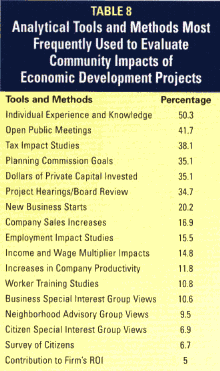 With the above breakdown in mind, it is insightful to consider the tools and methods employed by the two-thirds of economic development administrators who did use some type of cost benefit or impact analysis study to evaluate projects. Survey respondents were asked to rank seventeen types of analytical tools and methods that could be used to evaluate project impacts. Slightly over 50 percent of the administrators cited their own experience as the most frequently used tool and/or method used to evaluate community impacts. Table 8 shows the range of tools and methods used to evaluate project impacts. Note that the degree to which economic development administrators used the tools and methods declines from the moderate use of a few key measures to the infrequent use of several methods of evaluating and understanding project impacts.
With the above breakdown in mind, it is insightful to consider the tools and methods employed by the two-thirds of economic development administrators who did use some type of cost benefit or impact analysis study to evaluate projects. Survey respondents were asked to rank seventeen types of analytical tools and methods that could be used to evaluate project impacts. Slightly over 50 percent of the administrators cited their own experience as the most frequently used tool and/or method used to evaluate community impacts. Table 8 shows the range of tools and methods used to evaluate project impacts. Note that the degree to which economic development administrators used the tools and methods declines from the moderate use of a few key measures to the infrequent use of several methods of evaluating and understanding project impacts.
Economic development administrators also were asked to rate the importance of common impacts associated with economic development projects. As part of this rating, the survey sought information on the degree of importance the respondents felt that their respective municipality or agency placed on collecting and analyzing cost impact data related to economic development projects. Table 9 summarizes the project costs and impacts in terms of being very important and somewhat important.
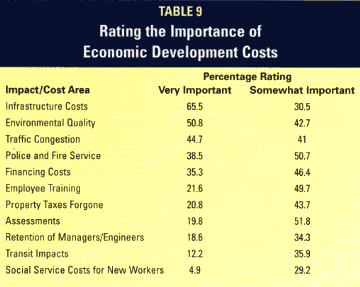
The importance of developing better insights into the practices of economic development officials cannot be understated. For some industries, projects and communities, this information may not be relevant — for now. However, things change, and the once friendly community may become highly critical of corporate site selection plans or an expansion project. In addition to objective third-party studies (economic, fiscal impact, market value, infrastructure and environmental impact) conducted for your firm, the research activities of local economic development administrators can prove to be a valuable resource to explain your firm’s position to the community and elected officials.
The value of impact and cost benefit studies conducted (or not conducted) by the public sector can be critical in the identification of your company’s contribution to and compatibility with a community. The information collected and the analysis performed by public agencies provides a way for politicians and citizens to better understand the value of your company as a member of a community. The information collected by economic development program administrators can go a long way in changing negative public attitudes about a project and can be a critical resource in the early identification of potential site location problems.


